DartPoints Maps Regional Strategy for Edge Computing Growth
DartPoints was one of the first service providers to target the market for edge computing. With a new capital partner and CEO, the company says it is ready to move ahead with its vision for a regional network of edge colocation centers.
Private equity firm Astra Capital Management recently acquired a majority interest in DartPoints, and says it will invest significant capital to create a network of regional edge infrastructure in the U.S.
“We’re going to have an aggressive deployment plan, and an aggressive acquisition plan,” said Scott Willis, the new President and CEO of DartPoints. “We’re looking for prospective targets that are good fit in our strategy.”
As a first step, DartPoints has expanded into Eastern Iowa, working with local telco South Slope Cooperative and IT service provider Aureon to deploy a carrier-neutral interconnection point in North Liberty, about 100 miles east of Des Moines. It is the first project outside Texas for DartPoints, which is based in Dallas.
There will be more to come. Astra has several investments in the IT and communications sector, and sees an opportunity in edge computing.
“They’re committed to investing in the (edge computing) space,” said Willis. “DartPoints is the initial platform, and we’re sharpening and clarifying our strategy. We’ve got a phased plan right now and a solid list of markets that are priorities.
“We’re looking for acquisition targets in these regional markets that will allow us to accelerate our strategy,” Willis continued. “We’re probably looking for smaller, pinpointed opportunities.”
Willis said DartPoints will focus on building its infrastructure in four regions of the U.S. – the Southwest, Southeast, Upper Midwest and Mid-Atlantic region. The company plans to steer clear of the Northeast and the West Coast. “Those are hyper-competitive markets,” he said. “The regions we’ve outlined represents about 30 of the 50 states.”
Building for the Present
DartPoints is among a number of providers targeting the edge computing sector as the emergence of the Internet of Things and AI reinforces the need for data centers in new places.
DartPoints began planning a distributed network of micro data centers in 2012, making it one of the early players in the edge computing sector. After slow growth in its early years, the company’s strategy has evolved amid growing interest in low-latency edge services.
Although next-generation technologies like autonomous cars may drive the future of edge computing, Willis said DartPoints is ready to build for use cases of the present.
“You’ve got to build a business around the needs of today, not driverless cars or the applications that aren’t here yet,” he said. “We are bringing what hyperscale and Tier 1 (data center) providers are doing today, and bringing that into the tier two and three markets. Our goal is to keep data local, so that you don’t have to backhaul.”
Willis sees a three- to four-year rollout for DartPoints’ initial round of edge facilities, and says the pandemic is a factor in demand for data center services. The newly-distributed workforce during the COVID-19 pandemic has accelerated the case for edge computing, which extends data processing and storage closer to the growing universe of devices and sensors at the edge of the network.
“The dynamics in the market have shifted a little bit, and I think we’ll see an acceleration of the move towards edge,” said Willis. “COVID is an element of that
Not Just Modular Anymore
After initially focusing on a repeatable modular design with a standard form factor, Willis emphasizes that DartPoints is branching out and will offer a range of options for customers.
“(Modular) is an element of our portfolio,” said Willis. “We are going to deploy the asset that best serves a market. It might be modular, or it might be buying a building, or we might lease office space and build a hybrid. We’re going to identify the best solution for each situation.”
“We are vendor agnostic,” said Loren Long, “The capacity, customer and purpose will all drive what we deploy. There is no cookie-cutter form factor. The repeatable part of our model is the customer service they can expect. It’s about the capability and the ecosystem we’re creating.”
That ecosystem will include cooling specialist TMGcore, which recently launched a data center enclosure that uses robots to swap high-density servers immersed in coolant fluid. It’s one of the most ambitious efforts yet to create a “lights out” autonomous data center.
“We have an ecosystem of partners, and are creating a marketplace,” said Willis. “TMGcore is one of them. You’re going to see some more announcements, come out shortly.”
About the Author



